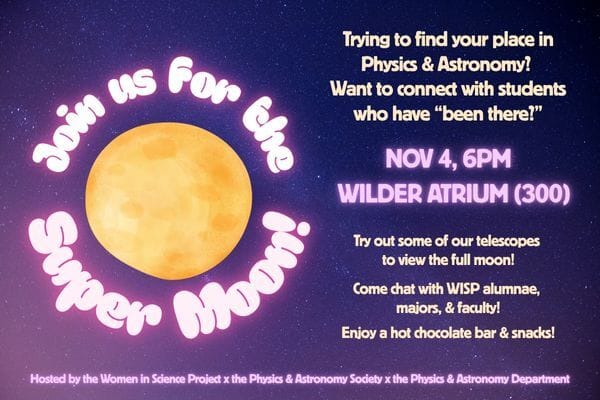- WISP Newsletter
- Posts
- WISP at Dartmouth: Oct 27-Nov 2, 2025
WISP at Dartmouth: Oct 27-Nov 2, 2025
October 20-26, 2025

Fall Term 2025: Week 7
It’s the week of Halloween, so we thought we’d share some seasonal science facts:
Research indicates that the melanistic gene responsible for the fur color of black cats may also have imbued them with a stronger immune system than their multi-colored peers.
Ever wonder how giant pumpkins get so big? Plant biologists believe that selective breeding has changed the vascular transport system of Cucurbita maxima (the giant pumpkin), allowing it to store carbs more efficiently in the fruit rather than supplying them to other parts of the plant.
Spiders have clear blood that turns blue when exposed to oxygen. Mammals use hemoglobin to transport oxygen, but spiders and some other creatures use hemocyanin instead. While hemoglobin has an iron atom at its center, hemocyanin contains copper. Hemocyanin absorbs all colors except blue, which it reflects, making the spider’s blood appear blue.
Mummies—some as old as 3,000 years—can still retain identifiable fingerprints.
The vampire asian moth (Calyptra thalictri) got its nickname because it uses its sharp, barbed proboscis to feed on the blood of vertebrates. Only the males of the species drink blood, though—the females stick to feasting on fruit.
On the subject of vampires, there is a type of star in binary systems called a “vampire star.” This occurs when a star grows large enough that its gravity begins to pull material from a neighboring star. As a result, the larger star gains mass, extending its own life, while the ‘victim star’ is left stripped down to its exposed core.
Have a safe and happy Halloween!
-The WISP Team
R.E.U Ready? Research Experience for Undergraduates (REU) Program at Dartmouth Info Sessions
Tuesday, October 28, 6:30-7:30PM
Wednesday, November 12, 5:30-6:30P
Online workshop
Get ready to take your STEM research skills to the next level with a Summer 2026 REU internship! Attend one of two workshops offered by Dartmouth Libraries for tips and tricks for searching for internships, organizing your applications, and writing your personal statement.
Visit dartgo.org/reu for more information.
Paleoanthropology Lab Tour
Thursday, October 30, 12:00-1:30PM
Basement of Silsby Hall, Room 013
Explore the 7 million year history of the human lineage in Dartmouth College's Paleoanthropology fossil lab which features hundreds of fossil replicas of our human ancestors and extinct relatives. Please note that access to this lab requires walking down a flight of stairs.
Please register here to attend.
Research Showcase: 10 Years of the Academic Clusters at Dartmouth
Thursday, October 30, 2:30PM
Hanover Inn Ballroom
Open to the public, come and see the tenth anniversary celebration of the Academic Cluster Initiative, highlighting interdisciplinary collaborations that have transformed the academic landscape at Dartmouth, initiated groundbreaking new research, and developed innovative ideas and solutions to some of the world’s most pressing challenges.
The event will feature high-energy TED-talk style presentations from lead cluster faculty exploring questions such as:
What are our brains trying to teach us?
What roles do rights, democracy, and capitalism play in a global world?
If everything is digital, is anything safe?
How will a changing Arctic impact the world?
Can sensory technology deliver longer, healthier lives?
Many of the clusters are STEM-focused or STEM-adjacent, and undergraduates are encouraged to attend.
Supermoon Party!
Tuesday, November 4, 6-7:00PM
Wilder Atrium (Wilder 300)
Cohosted by WISP, Physics & Astronomy, and the Physics & Astronomy Society, we welcome you to meet with physics majors and faculty, WISP alumnae, and other undergraduates who are exploring their place in these disciplines. We’ll also use the department’s small telescopes to view the full moon!
